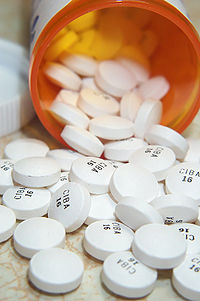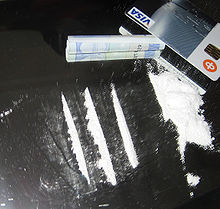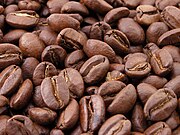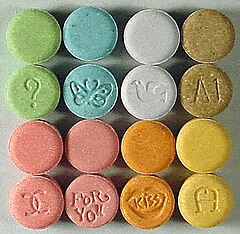兴奋剂
此条目需要精通或熟悉相关主题的编者参与及协助编辑。 (2017年4月15日) |


兴奋剂又称为中枢神经兴奋剂、中枢神经刺激剂(英语:Stimulant),是一系列可刺激中枢神经系统和脑部脊髓的精神药物统称,其中包括可以增加活动力的药物[1]、会令人感到愉快和振奋的药物,以及有交感兴奋作用的药物[2]。兴奋剂可以提升警觉心、注意力和活力,同时也增加血压、心跳和呼吸[3],常用作处方药(例如ADHD的儿童或成人[3]、嗜睡症、抑制食欲),但也有用于药物治疗以外的使用(可能是脱法药物或是非法使用),可能做为表现增强物质或是娱乐性药物。
一些药物能影响自我管理能力。例如:归类为中枢神经兴奋剂的药物:哌甲酯(methylphenidate)和安非他命(amphetamine)。适度适量使用,能提升一个人整体的冲动控制能力(inhibitory control),且被用来治疗注意力不足过动症(ADHD)患者。[4][5] 同理,中枢神经抑制剂(depressants)(例如:酒精)由于会让脑中神经传导物质浓度降低、减少许多大脑区域的活性等,所以可能会造成专注力、神智清醒度等自我管理能力的下降。[6]
在美国,2013年最常用的处方药兴奋剂有甲磺酸赖氨酸安非他命、哌甲酯及安非他命[7]。
作用机制
[编辑]大多数兴奋剂通过增强儿茶酚胺神经传递发挥其激活作用。儿茶酚胺神经递质被用于涉及注意力、唤醒、动机、任务显著性和报酬预期的调节途径中。经典的兴奋剂要么阻止再摄取,要么刺激这些儿茶酚胺的外排,导致其回路活动增加。一些兴奋剂,特别是那些具有致病和致幻作用的兴奋剂,也会影响血清素能的传递。一些兴奋剂,例如一些苯丙胺衍生物,尤其是育亨宾,可以通过拮抗调节性自体受体来减少负反馈。[8]肾上腺素能激动剂(例如,麻黄碱)通过直接结合并激活肾上腺素能受体而起作用,产生拟交感神经作用
药物还可以具有更多间接机制来激发激活作用。例如咖啡因是腺苷受体拮抗剂,仅间接增加儿茶酚胺在大脑中的传播。[9]而Pitolisant是H3受体反向激动剂。 由于H3受体主要充当自体受体,因此pitolisant减少了对组织胺能神经元的负反馈,从而增强了组织胺能传递。
常见的兴奋剂
[编辑]安非他命
[编辑]安非他命是苯乙胺类的强力中枢神经系统(CNS)兴奋剂,已被批准用于治疗注意力不足过动症(ADHD)和发作性嗜睡病。[10]安非他命也可以作为表现增强物质和认知增强剂使用,也可以作为春药和娱乐用的欣快剂使用。[11][12][13][14]尽管在许多国家或地区,安非他命是处方药,但未经控制或大量使用会带来严重的健康风险,因此经常严格控制安非他命的未经授权拥有和分发。[15][16]因此,许多安非他命是在秘密实验室非法制造的,并被贩运并出售给使用者。[17]根据全世界毒品的缉获情况,安非他命的非法生产和贩运比甲基安非他命要少得多。[17]
第一种药物安非他命是Benzedrine,这是一种用于治疗各种疾病的吸入器品牌。[18][19]由于右旋异构体具有更大的刺激性,因此逐渐停用Benzedrine,转而使用含有全部或大部分右旋苯丙胺的制剂。目前,通常将其处方为混合的苯丙胺盐、右旋苯丙胺和甲磺酸赖氨酸安非他命。[18][20]
苯丙胺是去甲基肾上腺素—多巴胺释放剂(NDRA)。它通过多巴胺转运体和去甲肾上腺素转运体进入神经元,并通过激活TAAR1和抑制VMAT2促进神经递质排出。[21]在治疗剂量下,这会引起情绪和认知影响,例如欣快感、性欲改变、唤起感增强和改善认知控制。[12][13][22]同样,它会诱发身体反应,例如减少反应时间、降低疲劳强度和增加肌肉强度。[11]相比之下,超过治疗剂量的安非他命可能会损害认知功能并引起横纹肌溶解。[10][12][23]超高剂量会导致精神病(例如妄想和偏执狂),即使长期使用治疗剂量,这种情况也很少发生。[10][23][24]由于娱乐剂量通常比规定的治疗剂量大得多,因此娱乐性使用会产生严重的副作用(例如依赖性)的风险要大得多,苯丙胺类药物的治疗很少会出现这种副作用。[10][23][24]
咖啡因
[编辑]
咖啡因是一种兴奋性化合物,属于黄嘌呤类化学物质,天然存在于咖啡、茶和(较小程度上)可可或巧克力中。它包含在许多软性饮料中,以及大量的能量饮料中。咖啡因是世界上使用最广泛的精神活性药物,也是迄今为止最常见的兴奋剂。在北美,每天有90%的成年人食用咖啡因。[25]一些司法管辖区限制其销售和使用。咖啡因也包括在某些药物中,通常是为了增强主要成分的作用或减少其某项副作用(尤其是嗜睡)。含有标准剂量咖啡因的片剂也可以广泛获得。
咖啡因的作用机制不同于许多兴奋剂,因为它通过抑制腺苷受体产生兴奋作用。[26]腺苷受体被认为是嗜睡和睡眠的主要驱动力,其作用随着清醒时间的延长而增强。[27]在动物模型中发现咖啡因可增加纹状体多巴胺,[28]并抑制腺苷受体对多巴胺受体的抑制作用,[29]然而,对人体的影响尚不清楚。与大多数兴奋剂不同,咖啡因没有成瘾性。咖啡因似乎不是增强刺激,实际上可能会发生某种程度的厌恶,在NIDA研究专著中发表的一项关于药物滥用责任的研究中,人们更喜欢安慰剂而不是咖啡因。[30]在大型电话调查中,只有11%的人报告了依赖症状。然而,当人们在实验室接受测试时,只有一半声称拥有依赖性的人实际经历过这种情况,这对咖啡因产生依赖性的能力产生了怀疑,并使社会压力成为人们关注的焦点。[31]
饮用咖啡与降低癌症的总体风险有关。[32]这主要是由于降低了肝细胞癌和子宫内膜癌的风险,但对大肠癌的影响也可能较小。[33]对于其他类型的癌症似乎没有显著的保护作用,而大量喝咖啡可能会增加患膀胱癌的风险。[33]咖啡因可能对阿兹海默症有保护作用,但证据尚无定论。[34][35][36]适量喝咖啡可以降低罹患心血管疾病的风险,[37]并且可以在某种程度上降低第2型糖尿病的风险。[38]与少喝或不喝咖啡相比,每天喝1-3杯咖啡不会影响患高血压的风险。但是,那些每天喝2至4杯的人的患病风险可能会略有增加。[39]咖啡因可增加青光眼患者的眼压,但似乎不影响正常人。[40]它可以保护人们免于肝硬化。[41]没有证据表明咖啡会阻碍孩子的成长。[42]咖啡因可能会提高某些药物的功效,包括用于治疗头痛的药物。[43]如果在登高海拔的山区几个小时前服用咖啡因,可能会减轻急性高山症的严重程度。[44]
麻黄碱
[编辑]麻黄碱是一种拟交感神经胺,其分子结构与众所周知的药物苯丙醇胺和甲基苯丙胺,以及重要的神经递质肾上腺素相似。麻黄碱通常用作兴奋剂、食欲抑制剂、浓缩助剂和减充血药,并用于治疗与麻醉有关的低血压。
从化学意义上讲,它是一种在麻黄属(麻黄科)的各种植物中发现的具有苯乙胺骨架的生物碱。其作用主要是通过增加去甲肾上腺素对肾上腺素能受体的活性。[45]它最通常以盐酸盐或硫酸盐的形式出售。
中药中使用的草药麻黄(Ephedra sinica)含有麻黄碱和伪麻黄碱作为其主要活性成分。含有其他麻黄种类提取物的其他草药产品也可能如此。
MDMA
[编辑]
3,4-亚甲二氧基甲基苯丙胺(MDMA, ecstasy,molly)是一种安非他命类的欣快剂、神入感激发剂和兴奋剂。[46]一些心理治疗师短暂地将其用作治疗的辅助手段,该药物在娱乐中大受欢迎,美国缉毒局将MDMA列为附表I受控物质,禁止大多数医学研究和应用。MDMA以其神入感激发作用特性而闻名。MDMA的刺激作用包括高血压,食欲不振,欣快感,社交抑制,失眠(增强清醒/无法入睡),能量改善,唤起感增强和排汗增加等。相对于儿茶酚胺能传递,与经典的兴奋剂(如安非他命)相比,MDMA显著增强了血清素能传递。MDMA似乎没有明显的成瘾或依赖性形成。[47]
由于MDMA的相对安全性,一些研究人员(例如David Nutt)批评了调度水平,撰写了一篇讽刺性的文章,发现MDMA的危险性比马术低28倍,他称这种情况为“马术”或“马匹成瘾综合症”。[48]
MDPV
[编辑]亚甲基二氧吡咯戊酮(MDPV)是一种兴奋性精神药物,具有刺激性,可作为去甲肾上腺素-多巴胺再摄取抑制剂(NDRI)。[49]它是由勃林格殷格翰公司的一个团队于1960年代首次开发的。[50]直到2004年左右,MDPV仍然是一种无名的刺激剂,当时有报导称它是作为设计药物出售的。标有含MDPV的浴盐的产品以前曾在美国的加油站和便利店以娱乐性用药的形式出售,类似于Spice和K2的营销。[51][52]
甲氧麻黄酮
[编辑]甲氧麻黄酮是苯丙胺和卡西酮类的合成兴奋剂。俗名包括drone[55]和MCAT。[56]据报导,它是在中国制造的,化学上类似于在东非卡塔植物中发现的卡西酮化合物。它以片剂或粉剂形式出现,使用者可以吞咽、鼻腔吸入或注射,产生与摇头丸、苯丙胺和可卡因相似的作用。
甲氧麻黄酮于1929年首次合成,但直到2003年重新发现后才广为人知。据报告,到2007年,甲氧麻黄酮可在互联网上出售; 到2008年,执法机构已意识到该化合物; 到2010年,在欧洲大部分地区都有报导,在英国尤为普遍。甲氧麻黄酮在2008年首先在以色列被定为非法,随后是瑞典。2010年,在许多欧洲国家/地区将其定为违法,2010年12月,欧盟裁定该法为违法。在澳大利亚、新西兰和美国,它被认为是其他非法药物的类似物,可以通过类似于《联邦模拟法》的法律加以控制。自2011年10月起,美国于2011年9月将甲氧麻黄酮暂时归类为非法。
甲基安非他命
[编辑]甲基苯丙胺是一种有效的苯乙胺和苯丙胺类兴奋剂,用于治疗注意力不足过动症(ADHD)和肥胖症。[57][58][59]甲基苯丙胺以右旋和左旋两种对映体形式存在。[60][61]与左旋甲基苯丙胺相比,右旋甲基苯丙胺是一种更强的中枢神经系统兴奋剂;[23][60][61]然而,它们都具有成瘾性,并且在高剂量时会产生相同的毒性症状。[61]尽管由于潜在的风险很少开处方,但盐酸甲基苯丙胺已被美国食品和药物管理局(USFDA)批准,商品名为Desoxyn。[58] 甲基苯丙胺在娱乐上被用来增加性欲,提升心情和增加精力,使一些使用者连续几天连续进行性活动。[58][62]
甲基苯丙胺可能以纯右旋甲基苯丙胺或左右手分子等比例混合的混合物(即50%左旋甲基苯丙胺和50%右旋甲基苯丙胺)非法出售。[62]在美国,右甲基苯丙胺和外消旋甲基苯丙胺均为附表II管制物质。[58]此外,由于甲基苯丙胺已列入《联合国精神药物公约》附表二,因此在许多其他国家受到限制或非法生产、分发、销售和拥有甲基苯丙胺。[63][64]相比之下,左旋苯丙胺是美国的一种非处方药。[注 1]
在低剂量下,甲基苯丙胺会引起疲劳的人情绪升高、提高机敏性、注意力和精力。[23][58]大剂量服用可诱发精神病、横纹肌溶解和脑出血。[23][58] 已知甲基苯丙胺具有很高的滥用和成瘾潜力。[23][58]娱乐性使用甲基苯丙胺可能会导致精神病或戒断后综合症,这种戒断综合症可以持续超过典型戒断期数月。[67]与苯丙胺和可卡因不同,甲基苯丙胺对人类具有神经毒性,会破坏中枢神经系统(CNS)的多巴胺和5-羟色胺神经元。[57][59]与长期使用苯丙胺完全相反的是,有证据表明,甲基苯丙胺会因长期使用而对人造成大脑损害; [57][59]这种损害包括大脑结构和功能的不利变化,例如减少灰质。 脑几个区域的血容量和代谢完整性标志物的不利变化。[68][69][59]
派醋甲酯
[编辑]派醋甲酯是一种中枢神经系统兴奋剂 其结构和药理与安非他命、古柯碱相似,能改善使用者的情绪和专注力,被应用于注意力不足过动症(ADHD)、嗜睡症、躁郁症和忧郁症的治疗。
古柯碱
[编辑]
可卡因是一种5-羟色胺、去甲肾上腺素和多巴胺再摄取抑制剂,可卡因由古柯灌木的叶子制成,古柯灌木生长在南美国家的玻利维亚、哥伦比亚和秘鲁等山区。在欧洲、北美和亚洲的某些地区,可卡因最常见的形式是白色结晶性粉末。可卡因是一种兴奋剂,尽管可卡因将临床用途视为局部麻醉剂,特别是在眼科领域,但由于其兴奋性而通常在治疗上并未开处方。可卡因的大多数使用是娱乐性的,其滥用潜力很高(高于苯丙胺),因此在大多数辖区都严格控制其销售和拥有。其他与可卡因有关的莨菪烷衍生物药物也众所周知,例如troparil和lometopane,但尚未广泛销售或用于娱乐。[70]
尼古丁
[编辑]尼古丁是烟草中的活性化学成分,有多种形式,包括香烟、雪茄、咀嚼烟草和戒烟辅助剂,例如尼古丁贴片、尼古丁口香糖和电子香烟。尼古丁具有刺激和放松作用,因此在世界范围内得到广泛使用。尼古丁通过烟碱乙酰胆碱受体的激动作用发挥其作用,从而导致多种下游效应,例如中脑奖赏系统中多巴胺能神经元活性的增加,其中一种烟叶乙醛降低了大脑中单胺氧化酶的表达。[71]尼古丁会上瘾并形成依赖性。烟草是尼古丁最常见的来源,对使用者和自己的总体危害比可卡因低3%,比苯丙胺高13%,在通过多标准决策分析确定的20种药物中,危害最大的是第六位。[72]
医疗用途
[编辑]中枢神经刺激剂在医学上用来治疗肥胖、睡眠障碍、嗜睡症(narcolepsy)、情感性障碍、注意力不足过动症、顽固型忧郁症、顽固型强迫症、气喘、鼻塞等[3][73]。
用来治疗 ADHD(注意力不足过动症)的兴奋剂包括哌甲酯、苯丙胺、右旋安非他命、二甲磺酸赖右苯丙胺等[3]。
安全性
[编辑]只要按照指示使用,中枢神经刺激剂如同其他药品一样安全,不会导致药物滥用或成瘾。
研究显示,以中枢神经兴奋剂治疗注意力不足过动症的患者,其往后将比没有以中枢神经兴奋剂治疗的注意力不足过动症患者享有明显更低的药物滥用风险[3]。
副作用
[编辑]如同其他药物,中枢神经刺激剂也有副作用产生的可能,然而不是每个服用兴奋剂的人都会有副作用。这些副作用大都是轻微的,并且在剂量降低或与其他药物并用、调整服药时间等调适后消失。
较常见的副作用[注 2]包含:
- 难以入睡或难以维持睡眠。
- 胃口降低。
- 胃部不适。
- 头疼。
- 肢体抽动或声音抽动。(突然的、重复的动作或声音)(抽搐)
备注
[编辑]参考文献
[编辑]- ^ stimulant - definition of stimulant in English | Oxford Dictionaries. Oxford Dictionaries | English. [2017-04-15]. (原始内容存档于2017-02-26).
- ^ Treatment, Center for Substance Abuse. Chapter 2—How Stimulants Affect the Brain and Behavior. Substance Abuse and Mental Health Services Administration (US). [2017-04-15]. (原始内容存档于2017-02-19) (英语).
- ^ 3.0 3.1 3.2 3.3 3.4 3.5 Mental Health Medications.. National Institute of mental health. (tertiary source). October 2016 [2017-04-15]. (原始内容存档于2019-04-06).
- ^ Spencer RC, Devilbiss DM, Berridge CW. The Cognition-Enhancing Effects of Psychostimulants Involve Direct Action in the Prefrontal Cortex. Biol. Psychiatry. June 2015, 77 (11): 940–950. PMID 25499957. doi:10.1016/j.biopsych.2014.09.013.
The procognitive actions of psychostimulants are only associated with low doses. Surprisingly, despite nearly 80 years of clinical use, the neurobiology of the procognitive actions of psychostimulants has only recently been systematically investigated. Findings from this research unambiguously demonstrate that the cognition-enhancing effects of psychostimulants involve the preferential elevation of catecholamines in the PFC and the subsequent activation of norepinephrine α2 and dopamine D1 receptors. ... This differential modulation of PFC-dependent processes across dose appears to be associated with the differential involvement of noradrenergic α2 versus α1 receptors. Collectively, this evidence indicates that at low, clinically relevant doses, psychostimulants are devoid of the behavioral and neurochemical actions that define this class of drugs and instead act largely as cognitive enhancers (improving PFC-dependent function). This information has potentially important clinical implications as well as relevance for public health policy regarding the widespread clinical use of psychostimulants and for the development of novel pharmacologic treatments for attention-deficit/hyperactivity disorder and other conditions associated with PFC dysregulation. ... In particular, in both animals and humans, lower doses maximally improve performance in tests of working memory and response inhibition, whereas maximal suppression of overt behavior and facilitation of attentional processes occurs at higher doses.
- ^ Ilieva IP, Hook CJ, Farah MJ. Prescription Stimulants' Effects on Healthy Inhibitory Control, Working Memory, and Episodic Memory: A Meta-analysis. J. Cogn. Neurosci. January 2015: 1–21. PMID 25591060. doi:10.1162/jocn_a_00776.
Specifically, in a set of experiments limited to high-quality designs, we found significant enhancement of several cognitive abilities. ... The results of this meta-analysis ... do confirm the reality of cognitive enhancing effects for normal healthy adults in general, while also indicating that these effects are modest in size.
- ^ Long-term & Short-term effects, depressants, brand names: Foundation for a drug free work. [2017-04-30]. (原始内容存档于2020-11-27).
- ^ Top 100 Drugs for Q4 2013 by Sales - U.S. Pharmaceutical Statistics. www.drugs.com. [2017-04-15]. (原始内容存档于2013-08-14).
- ^ Docherty, J R. Pharmacology of stimulants prohibited by the World Anti-Doping Agency (WADA). British Journal of Pharmacology. 7 January 2017, 154 (3): 606–622. ISSN 0007-1188. PMC 2439527
 . PMID 18500382. doi:10.1038/bjp.2008.124.
. PMID 18500382. doi:10.1038/bjp.2008.124.
- ^ Caffeine for the Sustainment of Mental Task Performance: Formulations for Military Operations.. Washington (DC): National Academies Press (US). 2001 [2020-11-07]. (原始内容存档于2017-10-09) (英语).
- ^ 10.0 10.1 10.2 10.3 Adderall XR Prescribing Information (PDF). United States Food and Drug Administration: 11. June 2013 [7 January 2014]. (原始内容存档 (PDF)于2014-10-06).
- ^ 11.0 11.1 Liddle DG, Connor DJ. Nutritional supplements and ergogenic AIDS. Prim. Care. June 2013, 40 (2): 487–505. PMID 23668655. doi:10.1016/j.pop.2013.02.009.
Amphetamines and caffeine are stimulants that increase alertness, improve focus, decrease reaction time, and delay fatigue, allowing for an increased intensity and duration of training...
Physiologic and performance effects
· Amphetamines increase dopamine/norepinephrine release and inhibit their reuptake, leading to central nervous system (CNS) stimulation
· Amphetamines seem to enhance athletic performance in anaerobic conditions 39 40
· Improved reaction time
· Increased muscle strength and delayed muscle fatigue
· Increased acceleration
· Increased alertness and attention to task - ^ 12.0 12.1 12.2 Malenka RC, Nestler EJ, Hyman SE. Chapter 13: Higher Cognitive Function and Behavioral Control. Sydor A, Brown RY (编). Molecular Neuropharmacology: A Foundation for Clinical Neuroscience 2nd. New York: McGraw-Hill Medical. 2009: 318. ISBN 978-0-07-148127-4.
Therapeutic (relatively low) doses of psychostimulants, such as methylphenidate and amphetamine, improve performance on working memory tasks both in individuals with ADHD and in normal subjects...it is now believed that dopamine and norepinephrine, but not serotonin, produce the beneficial effects of stimulants on working memory. At abused (relatively high) doses, stimulants can interfere with working memory and cognitive control, as will be discussed below. It is important to recognize, however, that stimulants act not only on working memory function, but also on general levels of arousal and, within the nucleus accumbens, improve the saliency of tasks. Thus, stimulants improve performance on effortful but tedious tasks...through indirect stimulation of dopamine and norepinephrine receptors.
- ^ 13.0 13.1 Montgomery KA. Sexual desire disorders. Psychiatry. June 2008, 5 (6): 50–55. PMC 2695750
 . PMID 19727285.
. PMID 19727285.
- ^ Wilens TE, Adler LA, Adams J, Sgambati S, Rotrosen J, Sawtelle R, Utzinger L, Fusillo S. Misuse and diversion of stimulants prescribed for ADHD: a systematic review of the literature. J. Am. Acad. Child Adolesc. Psychiatry. January 2008, 47 (1): 21–31. PMID 18174822. doi:10.1097/chi.0b013e31815a56f1.
Stimulant misuse appears to occur both for performance enhancement and their euphorogenic effects, the latter being related to the intrinsic properties of the stimulants (e.g., IR versus ER profile)...
Although useful in the treatment of ADHD, stimulants are controlled II substances with a history of preclinical and human studies showing potential abuse liability. - ^ Convention on psychotropic substances. United Nations Treaty Collection. United Nations. [7 January 2014]. (原始内容存档于2016-03-31).
- ^ Methamphetamine facts. DrugPolicy.org. [7 January 2014]. (原始内容存档于2018-04-17).
- ^ 17.0 17.1 Chawla S, Le Pichon T. World Drug Report 2006 (PDF). United Nations Office on Drugs and Crime: 128–135. 2006 [7 January 2014]. (原始内容存档 (PDF)于2013-05-30).
- ^ 18.0 18.1 Heal DJ, Smith SL, Gosden J, Nutt DJ. Amphetamine, past and present – a pharmacological and clinical perspective. J. Psychopharmacol. June 2013, 27 (6): 479–496. PMC 3666194
 . PMID 23539642. doi:10.1177/0269881113482532.
. PMID 23539642. doi:10.1177/0269881113482532.
- ^ Rasmussen N. Making the first anti-depressant: amphetamine in American medicine, 1929–1950. J. Hist. Med. Allied Sci. July 2006, 61 (3): 288–323. PMID 16492800. doi:10.1093/jhmas/jrj039.
- ^ Adderall IR Prescribing Information (PDF). United States Food and Drug Administration: 5. March 2007 [2 November 2013]. (原始内容存档 (PDF)于2013-09-26).
- ^ Miller GM. The emerging role of trace amine-associated receptor 1 in the functional regulation of monoamine transporters and dopaminergic activity. J. Neurochem. January 2011, 116 (2): 164–176. PMC 3005101
 . PMID 21073468. doi:10.1111/j.1471-4159.2010.07109.x.
. PMID 21073468. doi:10.1111/j.1471-4159.2010.07109.x.
- ^ Adderall XR Prescribing Information (PDF). United States Food and Drug Administration: 4–8. June 2013 [7 October 2013]. (原始内容存档 (PDF)于2014-10-06).
- ^ 23.0 23.1 23.2 23.3 23.4 23.5 23.6 Westfall DP, Westfall TC. Miscellaneous Sympathomimetic Agonists. Brunton LL, Chabner BA, Knollmann BC (编). Goodman & Gilman's Pharmacological Basis of Therapeutics 12th. New York: McGraw-Hill. 2010 [2020-11-05]. ISBN 978-0-07-162442-8. (原始内容存档于2013-11-10).
- ^ 24.0 24.1 Shoptaw SJ, Kao U, Ling W. Treatment for amphetamine psychosis (Review). Cochrane Database of Systematic Reviews. 2009, (1): CD003026. PMC 7004251
 . PMID 19160215. doi:10.1002/14651858.CD003026.pub3.
. PMID 19160215. doi:10.1002/14651858.CD003026.pub3.
- ^ Lovett R. Coffee: The demon drink?. New Scientist. 24 September 2005, (2518) [3 August 2009]. (原始内容存档于2008-10-11).

- ^ Nehlig, A.; Daval, J. L.; Debry, G. Caffeine and the central nervous system: mechanisms of action, biochemical, metabolic and psychostimulant effects. Brain Research. Brain Research Reviews. 1 August 2016, 17 (2): 139–170. PMID 1356551. doi:10.1016/0165-0173(92)90012-b.
- ^ Bjorness, Theresa E; Greene, Robert W. Adenosine and Sleep. Current Neuropharmacology. 8 January 2017, 7 (3): 238–245. ISSN 1570-159X. PMC 2769007
 . PMID 20190965. doi:10.2174/157015909789152182.
. PMID 20190965. doi:10.2174/157015909789152182.
- ^ Solinas, Marcello; Ferré, Sergi; You, Zhi-Bing; Karcz-Kubicha, Marzena; Popoli, Patrizia; Goldberg, Steven R. Caffeine Induces Dopamine and Glutamate Release in the Shell of the Nucleus Accumbens. Journal of Neuroscience. 1 August 2002, 22 (15): 6321–6324. ISSN 0270-6474. PMC 6758129
 . PMID 12151508. doi:10.1523/JNEUROSCI.22-15-06321.2002 (英语).
. PMID 12151508. doi:10.1523/JNEUROSCI.22-15-06321.2002 (英语).
- ^ Kamiya T, Saitoh O, Yoshioka K, Nakata H. Oligomerization of adenosine A2A and dopamine D2 receptors in living cells. Biochemical and Biophysical Research Communications. Jun 2003, 306 (2): 544–9. PMID 12804599. doi:10.1016/S0006-291X(03)00991-4.
- ^ Fishchman, N; Mello, N. Testing for Abuse Liability of Drugs in Humans (PDF). 5600 Fishers Lane Rockville, MD 20857: U.S. Department of Health and Human Services Public Health Service Alcohol, Drug Abuse, and Mental Health Administration National Institute on Drug Abuse. : 179 [2020-11-05]. (原始内容 (PDF)存档于2016-12-22).
- ^ Temple JL. Caffeine use in children: what we know, what we have left to learn, and why we should worry. Neuroscience and Biobehavioral Reviews. 2009, 33 (6): 793–806. PMC 2699625
 . PMID 19428492. doi:10.1016/j.neubiorev.2009.01.001.
. PMID 19428492. doi:10.1016/j.neubiorev.2009.01.001.
- ^ Nkondjock A. Coffee consumption and the risk of cancer: an overview. Cancer Lett. May 2009, 277 (2): 121–5. PMID 18834663. doi:10.1016/j.canlet.2008.08.022.
- ^ 33.0 33.1 Arab L. Epidemiologic evidence on coffee and cancer. Nutrition and Cancer. 2010, 62 (3): 271–83. PMID 20358464. doi:10.1080/01635580903407122.
- ^ Santos C, Costa J, Santos J, Vaz-Carneiro A, Lunet N. Caffeine intake and dementia: systematic review and meta-analysis. J. Alzheimers Dis. 2010,. 20 Suppl 1: S187–204. PMID 20182026. doi:10.3233/JAD-2010-091387.
- ^ Marques S, Batalha VL, Lopes LV, Outeiro TF. Modulating Alzheimer's disease through caffeine: a putative link to epigenetics. J. Alzheimers Dis. 2011, 24 (2): 161–71. PMID 21427489. doi:10.3233/JAD-2011-110032.
- ^ Arendash GW, Cao C. Caffeine and coffee as therapeutics against Alzheimer's disease. J. Alzheimers Dis. 2010,. 20 Suppl 1: S117–26 [2020-11-05]. PMID 20182037. doi:10.3233/JAD-2010-091249. (原始内容存档于2020-10-30).
- ^ Ding M, Bhupathiraju SN, Satija A, van Dam RM, Hu FB. Long-term coffee consumption and risk of cardiovascular disease: a systematic review and a dose-response meta-analysis of prospective cohort studies.. Circulation. 11 February 2014, 129 (6): 643–59. PMC 3945962
 . PMID 24201300. doi:10.1161/circulationaha.113.005925.
. PMID 24201300. doi:10.1161/circulationaha.113.005925.
- ^ van Dam RM. Coffee consumption and risk of type 2 diabetes, cardiovascular diseases, and cancer. Applied Physiology, Nutrition, and Metabolism. 2008, 33 (6): 1269–1283. PMID 19088789. doi:10.1139/H08-120.
- ^ Zhang Z, Hu G, Caballero B, Appel L, Chen L. Habitual coffee consumption and risk of hypertension: a systematic review and meta-analysis of prospective observational studies. Am. J. Clin. Nutr. June 2011, 93 (6): 1212–9. PMID 21450934. doi:10.3945/ajcn.110.004044.
- ^ Li M, Wang M, Guo W, Wang J, Sun X. The effect of caffeine on intraocular pressure: a systematic review and meta-analysis. Graefes Arch. Clin. Exp. Ophthalmol. March 2011, 249 (3): 435–42. PMID 20706731. doi:10.1007/s00417-010-1455-1.
- ^ Muriel P, Arauz J. Coffee and liver diseases. Fitoterapia. 2010, 81 (5): 297–305. PMID 19825397. doi:10.1016/j.fitote.2009.10.003.
- ^ O'Connor A. Never shower in a thunderstorm : surprising facts and misleading myths about our health and the world we live in 1st. New York: Times Books. 2007: 144 [15 January 2014]. ISBN 978-0-8050-8312-5. (原始内容存档于2020-02-12).
- ^ Gilmore B, Michael M. Treatment of acute migraine headache. Am Fam Physician. February 2011, 83 (3): 271–80. PMID 21302868.
- ^ Hackett PH. Caffeine at high altitude: java at base Camp. High Alt. Med. Biol. 2010, 11 (1): 13–7. PMID 20367483. doi:10.1089/ham.2009.1077.
- ^ Merck Manuals EPHEDrine (页面存档备份,存于互联网档案馆) Last full review/revision January 2010
- ^ Meyer, Jerrold S. 3,4-methylenedioxymethamphetamine (MDMA): current perspectives. Substance Abuse and Rehabilitation. 21 November 2013, 4: 83–99. ISSN 1179-8467. PMC 3931692
 . PMID 24648791. doi:10.2147/SAR.S37258.
. PMID 24648791. doi:10.2147/SAR.S37258.
- ^ Nutt, David; King, Leslie A.; Saulsbury, William; Blakemore, Colin. Development of a rational scale to assess the harm of drugs of potential misuse. Lancet. 24 March 2007, 369 (9566): 1047–1053. ISSN 1474-547X. PMID 17382831. doi:10.1016/S0140-6736(07)60464-4.
- ^ Editor, Christopher Hope. Ecstasy 'no more dangerous than horse riding'. Telegraph.co.uk. 2009-02-07 [4 December 2015]. (原始内容存档于2015-12-10).
- ^ Simmler, L. D.; Buser, T. A.; Donzelli, M.; Schramm, Y; Dieu, L-H.; Huwyler, J.; Chaboz, S.; Hoener, M. C.; Liechti, M. E. Pharmacological characterization of designer cathinones in vitro. British Journal of Pharmacology. 2012, 168 (2): 458–470. ISSN 0007-1188. PMC 3572571
 . PMID 22897747. doi:10.1111/j.1476-5381.2012.02145.x.
. PMID 22897747. doi:10.1111/j.1476-5381.2012.02145.x.
- ^ US Patent 3478050 – 1-(3,4-methylenedioxy-phenyl)-2-pyrrolidino-alkanones
- ^ Abuse Of Fake 'Bath Salts' Sends Dozens To ER. KMBC.com. 23 December 2010 [2020-11-06]. (原始内容存档于2011-07-13).
- ^ MDPV Bath Salts Drug Over The Counter. [2020-11-06]. (原始内容存档于2011-03-10).
- ^ Samantha Morgan. Parents cautioned against over the counter synthetic speed. NBC 33 News. 9 November 2010 [16 May 2011]. (原始内容存档于2011-09-28).
- ^ Kelsey Scram. Bath Salts Used to Get High. NBC 33 News. 6 January 2011 [16 May 2011]. (原始内容存档于2011-09-28).
- ^ Cumming, E. Mephedrone: Chemistry lessons. The Daily Telegraph (London). 22 April 2010 [14 September 2010]. (原始内容存档于2014-01-07).
- ^ Drugs crackdown hailed a success. BBC News. 8 March 2010 [31 March 2010]. (原始内容存档于2012-08-26).
- ^ 57.0 57.1 57.2 Malenka RC, Nestler EJ, Hyman SE. 15. Sydor A, Brown RY (编). Molecular Neuropharmacology: A Foundation for Clinical Neuroscience 2nd. New York: McGraw-Hill Medical. 2009: 370. ISBN 9780071481274.
Unlike cocaine and amphetamine, methamphetamine is directly toxic to midbrain dopamine neurons.
- ^ 58.0 58.1 58.2 58.3 58.4 58.5 58.6 Desoxyn Prescribing Information (PDF). United States Food and Drug Administration. December 2013 [6 January 2014]. (原始内容存档 (PDF)于2014-01-02).
- ^ 59.0 59.1 59.2 59.3 Krasnova IN, Cadet JL. Methamphetamine toxicity and messengers of death. Brain Res. Rev. May 2009, 60 (2): 379–407. PMC 2731235
 . PMID 19328213. doi:10.1016/j.brainresrev.2009.03.002.
. PMID 19328213. doi:10.1016/j.brainresrev.2009.03.002. Neuroimaging studies have revealed that METH can indeed cause neurodegenerative changes in the brains of human addicts (Aron and Paulus, 2007; Chang et al., 2007). These abnormalities include persistent decreases in the levels of dopamine transporters (DAT) in the orbitofrontal cortex, dorsolateral prefrontal cortex, and the caudate-putamen (McCann et al., 1998, 2008; Sekine et al., 2003; Volkow et al., 2001a, 2001c). The density of serotonin transporters (5-HTT) is also decreased in the midbrain, caudate, putamen, hypothalamus, thalamus, the orbitofrontal, temporal, and cingulate cortices of METH-dependent individuals (Sekine et al., 2006) ...
Neuropsychological studies have detected deficits in attention, working memory, and decision-making in chronic METH addicts ...
There is compelling evidence that the negative neuropsychiatric consequences of METH abuse are due, at least in part, to drug-induced neuropathological changes in the brains of these METH-exposed individuals ...
Structural magnetic resonance imaging (MRI) studies in METH addicts have revealed substantial morphological changes in their brains. These include loss of gray matter in the cingulate, limbic, and paralimbic cortices, significant shrinkage of hippocampi, and hypertrophy of white matter (Thompson et al., 2004). In addition, the brains of METH abusers show evidence of hyperintensities in white matter (Bae et al., 2006; Ernst et al., 2000), decreases in the neuronal marker, N-acetylaspartate (Ernst et al., 2000; Sung et al., 2007), reductions in a marker of metabolic integrity, creatine (Sekine et al., 2002) and increases in a marker of glial activation, myoinositol (Chang et al., 2002; Ernst et al., 2000; Sung et al., 2007; Yen et al., 1994). Elevated choline levels, which are indicative of increased cellular membrane synthesis and turnover are also evident in the frontal gray matter of METH abusers (Ernst et al., 2000; Salo et al., 2007; Taylor et al., 2007). - ^ 60.0 60.1 Kuczenski R, Segal DS, Cho AK, Melega W. Hippocampus norepinephrine, caudate dopamine and serotonin, and behavioral responses to the stereoisomers of amphetamine and methamphetamine. J. Neurosci. February 1995, 15 (2): 1308–1317. PMC 6577819
 . PMID 7869099. doi:10.1523/JNEUROSCI.15-02-01308.1995.
. PMID 7869099. doi:10.1523/JNEUROSCI.15-02-01308.1995.
- ^ 61.0 61.1 61.2 Mendelson J, Uemura N, Harris D, Nath RP, Fernandez E, Jacob P, Everhart ET, Jones RT. Human pharmacology of the methamphetamine stereoisomers. Clin. Pharmacol. Ther. October 2006, 80 (4): 403–420. PMID 17015058. doi:10.1016/j.clpt.2006.06.013.
- ^ 62.0 62.1 San Francisco Meth Zombies. Drugs, Inc.. 第4季. 第1集. 43 记录于. 11 August 2013 [2020-11-07]. ASIN B00EHAOBAO. National Geographic Channel. (原始内容存档于2016-07-08).
- ^ United Nations Office on Drugs and Crime. Preventing Amphetamine-type Stimulant Use Among Young People: A Policy and Programming Guide (PDF). New York: United Nations. 2007 [11 November 2013]. ISBN 9789211482232. (原始内容存档 (PDF)于2013-10-16).
- ^ List of psychotropic substances under international control (PDF). International Narcotics Control Board. United Nations. August 2003 [19 November 2005]. (原始内容存档 (PDF)于2005-09-07).
- ^ CFR TITLE 21: DRUGS FOR HUMAN USE: PART 341 – COLD, COUGH, ALLERGY, BRONCHODILATOR, AND ANTIASTHMATIC DRUG PRODUCTS FOR OVER-THE-COUNTER HUMAN USE. United States Food and Drug Administration. April 2015 [7 March 2016]. (原始内容存档于2015-09-18).
Topical nasal decongestants --(i) For products containing levmetamfetamine identified in 341.20(b)(1) when used in an inhalant dosage form. The product delivers in each 800 milliliters of air 0.04 to 0.150 milligrams of levmetamfetamine.
- ^ Levomethamphetamine. Pubchem Compound. National Center for Biotechnology Information. (原始内容存档于2014-10-06) 使用
|archiveurl=需要含有|url=(帮助).|section-url=被忽略 (帮助);|section=被忽略 (帮助); - ^ Cruickshank CC, Dyer KR. A review of the clinical pharmacology of methamphetamine. Addiction. July 2009, 104 (7): 1085–1099. PMID 19426289. doi:10.1111/j.1360-0443.2009.02564.x.
- ^ Hart H, Radua J, Nakao T, Mataix-Cols D, Rubia K. Meta-analysis of functional magnetic resonance imaging studies of inhibition and attention in attention-deficit/hyperactivity disorder: exploring task-specific, stimulant medication, and age effects. JAMA Psychiatry. February 2013, 70 (2): 185–198. PMID 23247506. doi:10.1001/jamapsychiatry.2013.277.
- ^ Spencer TJ, Brown A, Seidman LJ, Valera EM, Makris N, Lomedico A, Faraone SV, Biederman J. Effect of psychostimulants on brain structure and function in ADHD: a qualitative literature review of magnetic resonance imaging-based neuroimaging studies. J. Clin. Psychiatry. September 2013, 74 (9): 902–917. PMC 3801446
 . PMID 24107764. doi:10.4088/JCP.12r08287.
. PMID 24107764. doi:10.4088/JCP.12r08287.
- ^ AJ Giannini; WC Price. Contemporary drugs of abuse. American Family Physician. 1986, 33: 207–213.
- ^ Talhouth, Reinskje; Opperhuizen, Antoon; van Amsterdam G. C., Jan. Role of acetaldehyde in tobacco smoke addiction. European Neuropsychopharmacology. October 2007, 17 (10): 627–636. PMID 17382522. doi:10.1016/j.euroneuro.2007.02.013.
- ^ Nutt, David J.; King, Leslie A.; Phillips, Lawrence D. Drug harms in the UK: a multicriteria decision analysis. Lancet. 6 November 2010, 376 (9752): 1558–1565. ISSN 1474-547X. PMID 21036393. doi:10.1016/S0140-6736(10)61462-6.
- ^ Harper, S. J.; Jones, N. S. Cocaine: what role does it have in current ENT practice? A review of the current literature. The Journal of Laryngology and Otology. 1 October 2006, 120 (10): 808–811. ISSN 1748-5460. PMID 16848922. doi:10.1017/S0022215106001459.
